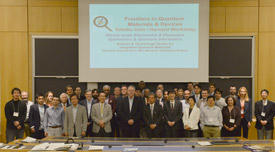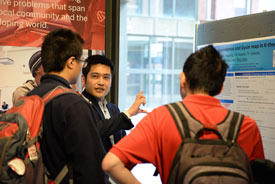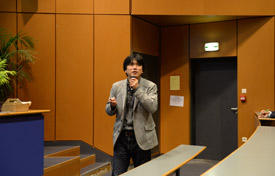

09/28/2015
AIMR researchers shared their latest innovations at several international workshops held in the United States and France during May. Speakers moved with ease through the many dimensions of materials science and mathematics, from proposing candidate spintronic devices for rapid and reliable information storage, to observing atoms, assembling molecular units and discussing abstract theoretical concepts. The global tour also strengthened relations between the AIMR and its key partners, including Harvard University, the C’Nano French centers of competence in the nanosciences and members of the wider WPI community in Japan.

Over the past five years, the AIMR has maintained a strong partnership with Harvard University founded on shared research interests and close collaboration between two physics professors: Robert Westervelt, director of the Center for Integrated Quantum Materials at Harvard University, and Hideo Ohno, a principal investigator at the AIMR. In 2013, delegates from Harvard attended a joint workshop hosted by Tohoku University; this time, researchers from Japan visited the Massachusetts campus of Harvard University to attend two workshops held consecutively on May 21 and 22. This occasion was marked by the extension of the academic co-operation agreement between Tohoku and Harvard for an additional five years.
On the first day of the workshop, researchers from countries as far flung as China, Switzerland and the Netherlands spoke on the theme of “Frontiers in Quantum Materials and Devices”. Among them, Ohno presented the pros and cons of different spintronic nanodevices for realizing nonvolatile very large-scale integration (VLSI), in which intelligent systems are integrated on a single chip. Specifically, he compared the data capacity, read–write speed and reliability of device structures based on magnetic tunnel junctions with those based on current-induced magnetization reversal. “The performance of each device is rapidly improving and practical nonvolatile VLSI will soon become a reality,” he said.
The oral presentations were followed by a poster session at which young researchers shared their work. Among them were four young researchers from Tohoku University, including an assistant professor from the AIMR, Koji Sato, who is taking a theoretical approach to the study of quantum materials.

Topological insulators have attracted considerable excitement because of their exceptional properties, which originate from their spatial configuration, or topology: they are insulators in the bulk, but their surfaces are conductors. These topological properties are described by topological indices, which can be obtained from their bulk properties or from their edge properties. Topological indices obtained in these two ways have been shown to coincide — a principle referred to as bulk–edge correspondence. Sato has provided a way to formulate the bulk–edge correspondence of topological insulators through the mathematical framework of K-theory. “Collaboration with mathematicians at the AIMR has been an eye-opening experience for me,” he said. “It has exposed me to interesting ideas and different angles.”
The workshop on the second day was exclusively for Tohoku and Harvard researchers to present research on a broad range of subjects. The day began with the Memorandum of Understanding Signing Ceremony between Tohoku University President Susumu Satomi and Richard McCullough, vice provost for research at Harvard University. This followed with introductions by Toshiya Ueki, executive vice president of Tohoku University, Motoko Kotani, director of the AIMR, William Wilson, executive director of the Harvard University Center for Nanoscale Systems, and Westervelt.
Among the first speakers was Hiroyuki Isobe, a principal investigator at the AIMR, whose laboratory recently succeeded in synthesizing a molecular bearing composed of freely rotating fullerene molecules embedded in finite single-walled carbon nanotube molecules. The bearing, said Isobe, could help realize nanoscale machines with minute friction at the interface — a prediction renowned physicist Richard Feynman made in his seminal 1959 lecture There’s plenty of room at the bottom. Isobe suggested that single-molecule chemical synthesis offered the most powerful technology to realize, for instance, tiny molecular motors.
The success of both workshops in the United States shows promise for the continued collaboration between the AIMR and Harvard University.
Flying across continents, AIMR researchers made their way to northwestern France to attend NanoMat 2015 in Rennes — a sister city of Sendai. The event was co-organized by six French C’Nano centers and four WPI institutes (MANA, iCeMS, I2CNER and the AIMR) and was spread over four days, 27–30 May 2015. Five AIMR researchers were invited to give talks and four young researchers presented posters at the gathering. The visit included a reception at Rennes City Hall, where Director Kotani gave a speech on behalf of the Japanese participants.

On the first day of scientific presentations, Shigemi Mizukami, a principal investigator at the AIMR, shared results from his experiments in which he used different materials to make magnetic tunnel junctions. These spin-based devices are already a core component of many spintronic technologies, notably magnetic read–write heads in hard disk drives and magnetic random access memory, but they have a huge unrealized potential for medical and technical applications, such as detecting magnetic nanoparticles and measuring magnetic fields radiating from the brain. Researchers, however, have struggled to develop magnetic tunnel junctions sensitive enough to measure weak magnetic fields. Mizukami introduced the junction devices recently developed by his collaborators, which could achieve the performances required to detect magnetic fields as weak as a picotesla, as demonstrated in his laboratory. Furthermore, Mizukami’s team has made headway in developing manganese-based magnetic tunnel junctions for application in high-density memory and telecommunications, as well as organic magnetic tunnel junctions, which could preserve spin information over extreme lengths.
Taro Hitosugi, a junior principal investigator at the AIMR, revealed the nanoscale surfaces and interfaces of an intriguing class of compounds called transition metal oxides, which are known for their versatile electronic, chemical, mechanical and thermoelectric properties. He presented clear images of atoms on the surfaces of thin films of oxide materials, as well as the electronic structure of the small area corresponding to each atom, observed using scanning tunneling microscopy and spectroscopy. Hitosugi further impressed the audience with a three-dimensional model of the surface atoms, which was constructed based on scanning tunneling microscopy images using a three-dimensional printer. The insights obtained from scanning tunneling microscopy and spectroscopy could also be used to obtain clues on how to improve lithium-ion battery performance. For example, the atomic-scale investigation of the electrode–electrolyte interface could enable higher lithium-ion conduction across the interface.
Participants gathered at the poster session, where Natsuhiko Yoshinaga, an assistant professor at the AIMR’s Mathematical Science Group, shared his theoretical research. Yoshinaga used a mathematical model to describe the formation of defects in a crystal — a poorly understood dynamic phenomenon.
The workshop organizing committee agreed to reunite next year for another France–Japan workshop at Kyushu University, in the southern island of Japan.
“The workshops in the United States and France are integral components of the AIMR’s strategy to promote international collaboration,” said Masaru Tsukada, administrative director at the AIMR who coordinated the Japan delegation attending the workshops. “The reputation of AIMR has been steadily increasing through such initiatives.”